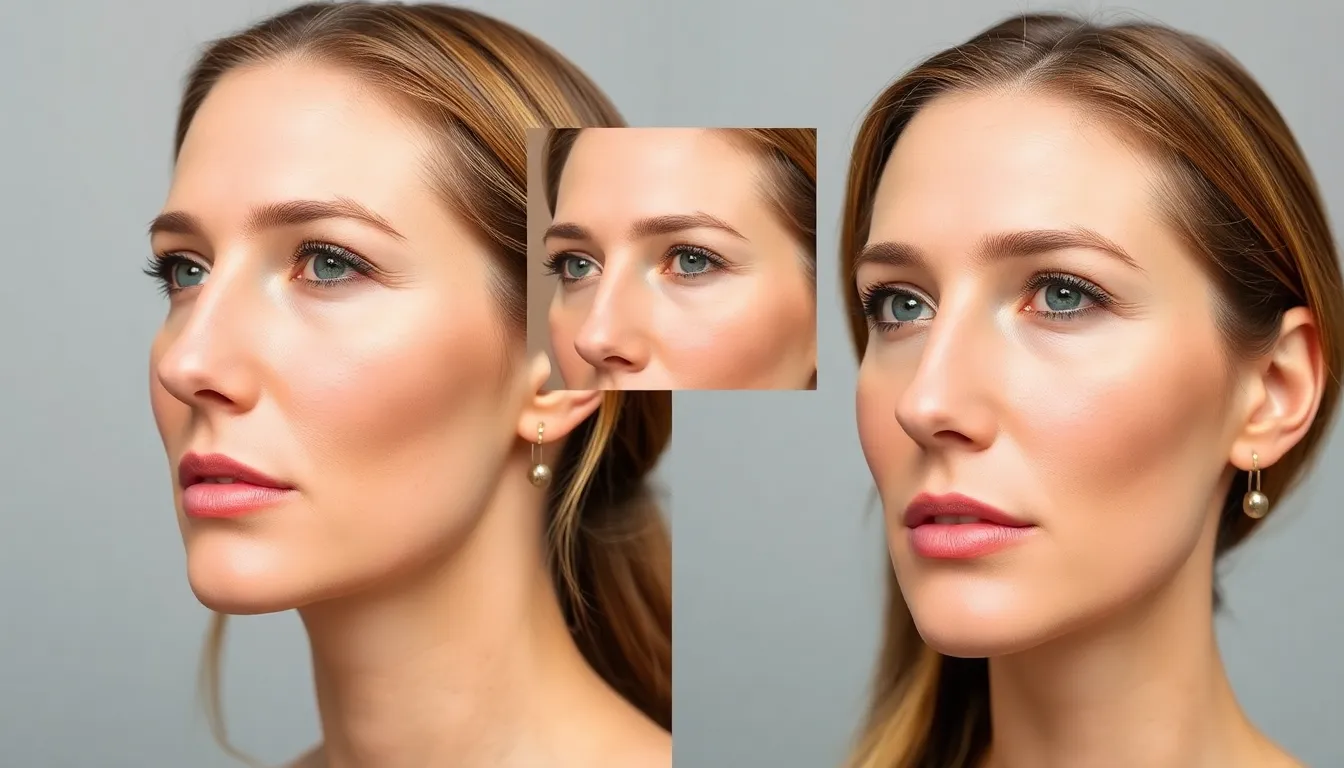Rhinoplasty can feel like a rollercoaster ride, complete with twists, turns, and the occasional loop-de-loop. For those considering this transformative journey, understanding the recovery process is crucial. What if you could peek behind the curtain and see exactly what happens day by day?
Table of Contents
ToggleOverview of Rhinoplasty Recovery
Rhinoplasty recovery unfolds through several stages, each characterized by distinct changes. Day one marks the beginning of healing, when swelling and bruising around the nose often become noticeable. Patients typically experience discomfort, which can be managed with prescribed medications.
By day three, bruising may deepen, and swelling peaks. It’s crucial to keep the head elevated during this time. Sticking to a soft diet helps patients avoid strain while eating.
On day five, some bruising starts to fade, bringing slight relief. Most individuals return to normal activities but should still avoid strenuous exercise. Gentle walking can promote circulation without causing undue stress.
Days seven to ten signal significant progress in recovery. A follow-up appointment may occur around this time, allowing doctors to assess healing and remove any splints or stitches if applicable. Many patients report improved breathing and less swelling.
Two weeks post-surgery, substantial changes become evident. Bruising typically resolves, and more defined nasal features emerge. Resuming regular activities is generally possible, but caution with physical contact to the nose remains essential.
At the one-month mark, many individuals notice the final results starting to manifest. While swelling continues to improve, it’s essential to note that full results may take upward of a year. Staying hydrated and following post-operative care instructions significantly aids in the overall healing process.
Importance of Rhinoplasty Recovery Photos

Rhinoplasty recovery photos play a crucial role in capturing the healing journey. These images provide a visual timeline that highlights changes over the days and weeks following surgery.
Visual Documentation
Visual documentation of recovery stages offers invaluable insights. Each photo captures distinct healing phases, from immediate swelling to gradual definition of nasal features. This collection helps individuals track their progress clearly and assess how their results evolve. It also serves as a reference for what to expect, aiding in understanding the timeline and potential changes. Surgeons and patients alike benefit from this documentation, as it informs future discussions about post-operative care and realistic outcomes.
Emotional Impact
Experiencing a significant transformation can evoke a range of emotions. Rhinoplasty recovery photos often help patients process these feelings. They provide a visual affirmation that encourages confidence and patience during the healing process. Observing progress can alleviate anxiety associated with uncertainties about final results. Sharing these images within support groups fosters a sense of community, as individuals relate to one another’s experiences. Positive feedback from others can enhance self-esteem and reinforce emotional resilience.
Day-by-Day Recovery Process
Understanding the individual steps of the rhinoplasty recovery process provides essential insights into what patients can expect. This section reviews each significant day during recovery, highlighting changes and progress.
Day 1: Immediately After Surgery
Patients typically experience noticeable swelling and bruising. Discomfort around the nose often accompanies these symptoms, making pain management essential. Ice packs can help alleviate some swelling. Keeping the head elevated plays a crucial role in minimizing discomfort. Expect frequent naps as the body begins to heal from the procedure.
Day 3: Swelling and Bruising
Significant swelling peaks by day three, resulting in more pronounced bruising. Nausea may accompany the discomfort, but prescribed medication aids in easing this symptom. Patients find eating soft foods easier during this period. Staying hydrated contributes to recovery as well. Elevating the head remains essential for comfort and minimizing swelling.
Day 7: Initial Healing
By day seven, many notice a gradual reduction in bruising and swelling. The initial healing stage presents an opportunity to assess progress. Follow-up appointments are common during this phase to examine recovery and remove splints if necessary. Increased energy levels can prompt patients to resume light activities. Positive emotional shifts often occur as results begin to show.
Week 2: Decreased Swelling
Significant improvement is typical by the second week, with swelling and bruising continuing to decrease. Patients often report a clearer nasal profile. Resuming regular activities becomes possible, but caution remains vital regarding intense exercise. Patience is crucial, as final results might not yet be visible. Maintaining hydration continues to support optimal healing.
Week 4: Returning to Normal Activities
By week four, most individuals return to normal activities, feeling more confident in their appearance. Any remaining minor swelling typically fades during this period. Patients often receive green lights from their surgeons to resume most daily routines. Fine details of the nasal shape begin to emerge clearly. Keeping up with follow-up appointments ensures a supportive recovery process.
Tips for Capturing Recovery Photos
Capturing recovery photos during rhinoplasty provides a visual timeline of healing. Start by selecting a consistent location with good lighting to take photos. Natural light often produces clearer images, enhancing visibility of changes.
Use the same angle for each photo to create a uniform comparison. Front and profile shots help showcase overall changes effectively. A neutral background minimizes distractions, keeping the focus on the face.
Consider taking photos at specific intervals. Daily photos for the first week show immediate changes, while weekly photos afterward help document longer-term recovery. Mark each image with the date to track progress accurately.
Encourage using a tripod or stable surface to maintain camera positioning. Stability enhances clarity and eliminates blurriness in images. It’s also useful for comparing early photographs to later ones.
Avoid using filters or editing tools to alter original photos. Authentic images provide a true representation of the recovery process. Honest documentation aids in managing expectations and addressing emotional responses.
Patients should also consider journaling alongside photo documentation. Written reflections on feelings and experiences enrich the visual timeline. Sharing these stories within support communities can foster connections with others undergoing similar journeys.
By combining notes with consistent photography, individuals create a comprehensive account of their recovery. This practice not only highlights progress but also serves to instill confidence and optimism during the healing process.
The journey of rhinoplasty recovery is filled with significant changes that can be effectively documented through daily photos. These images not only capture physical transformations but also serve as a source of motivation and reassurance during the healing process. By following the tips for taking consistent and authentic photos, patients can create a meaningful visual record of their recovery.
As individuals progress through each stage of healing, they’ll likely experience a mix of emotions. This documentation can foster a sense of community and provide valuable insights into the recovery journey. Ultimately, embracing this process with patience and positivity can lead to a fulfilling outcome that enhances both appearance and confidence.

